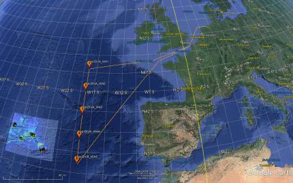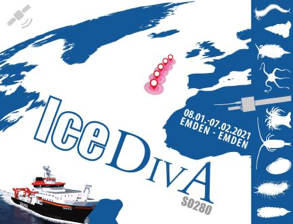[From Deep-Sea Life 16]
Saskia Brix
Senckenberg Research Institute, Germany
Email: sbrix@senckenberg.de
Concurrent with the start of the UN Ocean Decade, the IceDivA expedition is launched to record marine biodiversity in the Atlantic deep sea.
Wilhelmshaven, 23 December 2020. On 8 January 2021, a team of 21 scientists aboard the research vessel SONNE set out on an expedition (IceDivA as SO280 (GPF 20‐3_087)) in the Atlantic to study the diversity of marine organisms in the deep sea. They intend to collect samples from the Iceland Basin to the Azores at depths between 4,000 and 5,000 meters and map the ocean floor by means of hydroacoustics. To date, the deep-sea ecosystem has been studied less extensively than the far side of the moon. The team hopes that the IceDivA expedition will contribute to a better understanding of the deep-sea biome, ultimately leading to more efficient conservation measures.
The primary focus of the expedition on the research vessel SONNE (SO280 (GPF 20‐3_087)) is to study the distribution of deep-sea species. In this context, IceDivA can build on the findings of several preceding projects – e.g., the end point of the previous expedition IceAGE3 (SO276 in the summer of 2020) defines the starting point of the current journey. The integration of data from previous expeditions forms a central component of the IceDivA expedition. The comparable and consistent use of equipment and standardized sampling techniques make it possible to evaluate paradigms regarding biodiversity, species inventory, and species composition in relation to depth and width.
The IceDivA expedition connects two deep-sea projects in this regard: IceAGE (Icelandic marine Animals: Genetics and Ecology) and DIVA (Latitudinal Gradients in BioDIVersity in the deep Atlantic) as well as the EU project iAtlantic. IceAGE is an established international project that was initiated in 2011 and builds on the preceding project BIOICE (Benthic Invertebrates of Icelandic Waters). By connecting to the southernmost IceAGE3 station, IceDivA adds a latitudinal gradient, which in turn forms a link to the BIODIAZ project (Controls in benthic and pelagic BIODIversity of the AZores). The study area is located in one of the regions of interest of the EU project iAtlantic (e.g., the Porcupine deep-sea plain and the Azores plateau), which studies the health of ecosystems at the high seas and the deep-sea regions in the Atlantic Ocean. A contiguous and comprehensive mapping of the ocean floor by means of hydroacoustics is an indispensable prerequisite for identifying habitats – one of the iAtlantic project’s primary tasks, and an equally important objective in the IceDivA project.

Copyright: Alexander Kienecke
In addition to the biological studies, the “DArgo2025_RBRpilot” project will also be on board. As part of this project, a total of 10 ARGO floats by different manufacturers will be equipped with sensors for measuring the salinity, temperature and pressure (CTD) to compare their respective performance. Breaking with the traditional approach, on this expedition the floats will be released as a swarm in a single position, if possible, to obtain an initial direct comparison of the measuring parameters. Concurrently, the water column in the release area will be examined at a fine scale with onboard CTD sensors. These measurements serve as a reference for assessing the ARGO float data. During the course of the expedition on the research vessel SONNE, after their successful release, the floats will repeatedly dive to depths of 2,000 meters and return to the surface 48 hours later to transmit the collected data via satellite to a data center.
Led by the team from Senckenberg am Meer, the IceDivA expedition will involve 21 scientists from such institutions as the Federal Maritime and Hydrographic Agency (BSH), the British Antarctic Survey (BAS), GEOMAR, and the Universities of Hamburg and Oldenburg. In order for the expedition to go ahead in the current Covid-19 influenced world, all participants must adhere to a 14-day domestic self-quarantine over Christmas and New Year, and go to a multi-day “test camp” in which two Corona tests are carried out before the expedition. The expedition will start in Emden on January 8th, 2021 and will return to Emden on February 7th after 5 weeks at sea.
Follow the trip: https://www.iceage-project.org/icediva-current-project/
To study and understand nature with its unlimited diversity of life forms, and to preserve and manage it in a sustainable fashion as the basis of life for future generations – that has been the goal of the Senckenberg Gesellschaft für Naturforschung (Senckenberg Nature Society) for the past 200 years. This integrative “geobiodiversity research” and the dissemination of research and science are among Senckenberg’s primary tasks. Three natural history museums in Frankfurt, Görlitz, and Dresden display the diversity of life and the earth’s development over millions of years. The Senckenberg Gesellschaft für Naturforschung is a member of the Leibniz Association. The Senckenberg Natural History Museum in Frankfurt is supported by the City of Frankfurt am Main as well as numerous other partners. Additional information can be found at www.senckenberg.de.

